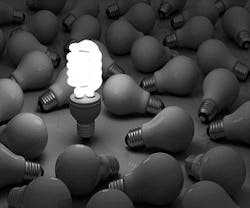America’s Next Top Energy Innovators Announced
The field of 14 startups participating in the America’s Next Top Energy Innovator challenge has been narrowed down to the three winners. Americans chose the top innovators by casting nearly half a million votes online from January to February, with an expert panel conducting a separate review on the potential economic and societal contributions from the startup companies.
The three winners are as follows:
IPAT, a startup company based in Nevada, Iowa, is using gas atomization technology developed at Ames Laboratory to make titanium powder with processes that are ten times more efficient than traditional powder-making methods — significantly lowering the cost of the powder to manufacturers. The powder form of titanium is easier to work with than having to cast the metal — where manufacturers melt and pour liquid metal into molds — particularly given titanium’s tendency to react with the materials used to form molds. Titanium’s strength, light weight, biocompatibility and resistance to corrosion make it ideal for use in a variety of parts — from components for artificial limbs — like those used by wounded veterans returning from Iraq and Afghanistan — to military vehicle components, biomedical implants, aerospace fasteners and chemical plant valves.
Umpqua Energy, a startup company based in Medford, Oregon, is using an Argonne National Laboratory technology to develop a system that allows a gasoline engine to operate in an extreme lean burn mode in order to increase gasoline mileage. One negative side effect of a lean burn engine, whether powered by gasoline or diesel fuel, is an increase in the amount of harmful gases released to the environment. The company expects to both increase fuel economy and simultaneously reduce emissions with its system. View a video on the company’s technology HERE.
Vorbeck Materials , a startup company based in Jessup, Maryland, is using a Pacific Northwest National Laboratory (PNNL)-developed method for building tiny chemical structures to greatly improve the performance of lithium-ion batteries. Lithium-ion batteries are rechargeable batteries that are widely used in portable devices such as laptops and power electric vehicles. Vorbeck is using PNNL’s method to develop better lithium air and lithium sulfur batteries. The new material in Vorbeck’s batteries stores twice as much electricity at high charge and discharge rates as current lithium-ion batteries, and creates increased battery capacity and a longer cycle life. View a video on the company’s technology HERE.
"Congratulations to the winning companies for this year’s America’s Next Top Energy Innovator Challenge. These innovative startup companies are leading the way in creating new businesses based on discoveries made by our world-leading national laboratories,” says Energy Secretary Chu. “Through this challenge and the Obama Administration’s Startup America Initiative, we are unleashing startup companies to do what they do best: create new products, new industries, and new jobs.”
